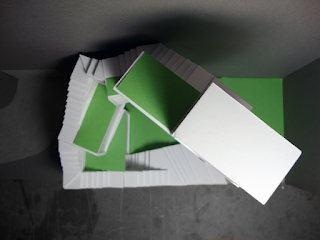This is my latest project from the university, and it was due complete by the end of December 2010. The focus in this project has been to work with limited space at a challenging location, while also making a design that is specific to a certain individual. Our site of the building was a tiny, narrow alley in Copenhagen, surrounded by 14-18 meter tall buildings, where natural lighting was rare and the views provided were boring and unaesthetic. We were given specific volumes for four rooms - Bathroom, livingroom, kitchen and bedroom - And were from these masses to create a single-person home. The person who was to live in the structure was given to us by random - Each with a different personality. Below is a picture of the actual site.
Now before I proceed to my design process, it is vital for you to understand the personality of the inhabitant, since it is the thing that has led me to my final design. (Do note, that this is a fictious person, made up to create a more realistic architectural exercise. The inhabitant - Sofie, as she is named - is a young 30-year old woman. She has by the age of 30 already had vital job positions in art and sculptural centers in metropolises such as New York and Berlin. Her newest and current job at the time of the project is that of a head-manager of a center for light and sound art in Copenhagen (our current architectural project at the time being - I'll naturally post on it once it is complete). As you may have noticed by now, Sofie seems to have a rather busy lifestyle, and a personality that probably favors her work, rather than her sparetime interests. This has been a very vital element in my design of her new home. Below here, is a step by step guide to the process.
Now as you can see on the illustrations above, I quite simply start of by sorting out the different room volumes. Since there is very little lighting in the narrow and dark alley, I have chosen to give the structure as much height as possible - This I have done by starting off by stacking the volumes on top of each other, thus creating a maximal height (shown on the top right illustration). As i gain height, I notice that the structure becomes slightly dull, and that it is a pity that the roofings aren't open for use as terraces, so I shift every floor so that an exterior space is created on each of these floors (illustration at the bottom left). Finally since the structure needs to fit in the narrow alley, I turn the entire structure, so its width fits in the site. This twist in the alley is not just to make the structure fit in, but also to create a more exciting space, so the inhabitant doesn't have to stare at plain old walls all the time. This twisty design is by no means accidental either, since it symoblizes Sofie's busy and dynamic lifestyle. Furthermore, the entire structure is a symbol of her needs - Her office and work space are located at the highest block, while her bedroom - Her sanctuary of rest - Is located at the very bottom. These placings of rooms represent her needs and are prioritized by her goals in life, putting her job at the top.
Now in order to connect all these five rooms, I created a staircase system that connects them, as illustrated on the facade drawings above. The staircase symbolizes, although almoste litterally, Sofie's fight to reach the top in her line of work, where on top of the structure, her office stands almost as a temple-like monument, overlooking the climb upwards. You may also have noticed that this staircase system may be rather unpractical, and honestly, it is. Do mind that this was an excercise with working under rather challenging conditions, and the spacial design was according to our professor more vital than that of one that is realistic in this certain project. I had planned an exterior construction that would cover up the staircase system, but was advised not to use it, since it would lead me away from the vital excercise. Below are pictures of my final model, which took me ages to complete, due to the many, many troublesome stairs!
This project thought me a vital lesson with especially how important it can be to have a certain personality drive the project's design. In the very early stages of the project, we weren't given information about our inhabitant and were told to work freely with whichever shapes and forms we desired. At this stage I had great trouble finding the right design and was at certain points, well, completely lost. But after having revealed our inhabitant, it was a matter of very few days before I had found the exact design that I needed. It seems that the more possibilities and freedoms you have with the design, the harder it is to find the right one.
- Andy Minchev












